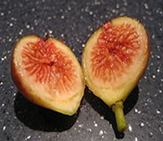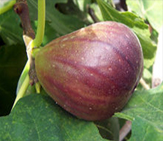Ficus religiosa (Peepal tree): An Ayurvedic Medicine
Babita Bhatt, Akshita Banga, Dibya Joshi
 Peepal is a large, fast growing deciduous tree belongs to Moraceae family. It has heart shaped leaves. It is common throughout India, often planted in the vicinity of the temples. It is a medium size tree and has large crown with the wonderful wide spreading branches. It shed its leaves in the month of March and April. The fruits of the Peepal are hidden with the figs. The figs ripen in the month of May. The figs which contain the flowers grow in pairs just below the leaves and look like the berries. Its bark is light gray and peels in patches. Its fruit is purple in colour. It is one of the longest living trees. No other tree is claimed to have such a long life - one in Sri Lanka, said to have been planted in the year 288 B.C., still lives and flourishes. Other common names for a Ficus religiosa tree are peepal, pipul, ficus, fig, bodhi and sacred tree.
Peepal is a large, fast growing deciduous tree belongs to Moraceae family. It has heart shaped leaves. It is common throughout India, often planted in the vicinity of the temples. It is a medium size tree and has large crown with the wonderful wide spreading branches. It shed its leaves in the month of March and April. The fruits of the Peepal are hidden with the figs. The figs ripen in the month of May. The figs which contain the flowers grow in pairs just below the leaves and look like the berries. Its bark is light gray and peels in patches. Its fruit is purple in colour. It is one of the longest living trees. No other tree is claimed to have such a long life - one in Sri Lanka, said to have been planted in the year 288 B.C., still lives and flourishes. Other common names for a Ficus religiosa tree are peepal, pipul, ficus, fig, bodhi and sacred tree.
Ficus religiosa or Sacred fig is worshiped by the Hindus and Buddhists because it is a very sacred tree in their beliefs. It is found throughout India. Peepal tree is grown throughout India. It is mainly grown in the state of Haryana, Bihar, Kerala and Madhya Pradesh. Its bark contains 4% tannins. Besides, it contains certain alakloids and minerals and certain vitamins. It functions as an astringent, anti-diarrheal, anti-dysenteric, laxative, anti-asthmatic, and anti-fungal agent.
Chemical constituents of this herb include Sterols like Lanosterol, ß-Sitosterol and its glucoside, stigmasterol, lupen-3-one are present in the bark2,3 and campestrol, stigmasterol, 28-isofucosterol, a-amyrin, ß-amyrin and lupeol in the leaf; Coumarins Bergapten and bergaptol in the bark; Tannins like tannic acid in the leaves; Aminoacids Asparagine and tyrosine in the fruit; alanine, threonine, tyrosine and valine from the seed 6 and arginine, serine, aspartic acid, glycine, threonine, alanine, proline, tryptophan, tyrosine, methionine, valine, isoleucine, leucine and others in the leaf; Vitamins like Kl in the stem; Hydrocarbons and aliphatic alcohols n-Nonacosane, n-hentriacontanen-hexacosanol, n-octacosanol in the leaves; and minerals like calcium, iron, copper, manganese and zinc are present in the leaves.
 Medicinal Value :- Medicinal Value :-
Ficus religiosa trees have abundant important medical uses. They are considered as herbs. According to Ayurveda, it works as astringent to bowels, useful in treatment of biliousness, ulcers, erysipelas, vomiting, vaginal complains, fever, inflammations, leprosy. According to Unani system of medicine, its latex is aphrodisiac, tonic, vulernary, maturant, lessens inflammations, useful in piles, nose-diseases, gonorrhea etc. The aerial root is styptic, useful in syphilis, biliousness, dysentery, inflammation of liver etc. Six parts of the trees (i.e., seeds, bark, leaves, fruit, latex and roots) are valued for their medicinal qualities. The only part not used for therapeutic purposes is the wood because it is highly porous.
Leaves : The leaves are the most useful parts of Ficus religiosa. They can be used for the fresh juice that is extracted from the leaves. People who do not live near a Ficus religiosa most likely use its leaves in powered form. The leaves can be used to alleviate fevers, bleeding wounds, constipation, dysentery, bruises, boils and mumps. The leaves can either be consumed or poured on the wound, boil or mump.
Fruit : The fruit helps support healthy digestive movement. In the case of an upset stomach, taking the powdered form of the fruit with a warm glass of milk will help to settle the stomach, or help purge if necessary. Fresh fruit is also used to treat dehydration and prevent heart disease. They can even be used in emergency situations when a victim consumes poison.
 |  |
| Fig :Inside of a ripe brown Turkish |
Fig :Common Fig syconium (fruit) |
Roots : The root is used to alleviate an inflammation. The roots are good for people suffering from gout, in which uric acid builds up in the joints, causing much pain. This form of arthritis can be cured by the use of root because it decreases the levels of uric acid. The root can also be chewed to help prevent gum disease. The bark from the root is particularly helpful to treat lower back pain, stomatitis (any of numerous inflammatory diseases of the mouth) and ulcers.
Latex : According to SelfGrowth.com, the latex of Ficus religiosa is combined with the roots of another plant, Asclepias curassavica, to treat skin diseases. The latex is combined with juice of the roots, which can help treat a wide variety of skin diseases, including ringworm, athlete's foot and other fungal diseases on the skin.
Bark: The bark has been known to heal wounds. It can be also used in cases of inflammation, including the swelling of the glands. The bark also is used to treat jaundice patients by reducing the amount of urination.
Seeds : The seeds of a Ficus religiosa can help with bladder conditions.
|
 Agrotechnology Agrotechnology
Ecology :-
It is found scattered in forests, where it propagates as an epiphyte on other trees especially widely found in uplands and plane area.
Biophysical Limits :-
Altitude : up to 1520 m
Mean annual temperature: 16-35ºC
Mean annual rainfall: 500-5000 mm
Soil Type :- It grows on a wide variety of soils but prefer deep, alluvial sandy loam with good drainage. It is also found on shallow soils including rock crevices. It can be cultivated in rocky areas, unused lands, or other wastelands of the farmyard.
Irrigation :- Most ficus species are a bit drought tolerant that is they can survive for a while without regular watering. But to keep the plant in a healthy condition, water it regularly and allow the top two inches of soil around the plant to dry before watering it again. Brown leaf tips indicate under-watering while yellow tips indicate over-watering. Also, whole leaves turning yellow might indicate over watering and falling leaves under watering. Just we have to check watering routines while having any of these issues with leaves.
Propagation :- The plant is vegetatively propagated by stem cuttings. A few species are also seed propagated. Stem cuttings of pencil thickness taken from the branches are to be kept for rooting. Rooted cuttings are to be transplanted to prepared pits. A newly bought plant will sometimes drop some leaves, that is because the it is adjusting to the new environment and there is no need to worry about it. Prune the near-dead leaves still clinging to the plant. Also prune dry twigs. No regular manuring is required.
The plant is not attacked by any serious pests or diseases. Bark can be collected after 15 years. Ficus species generally has an economic life span of more than hundred years. Hence, bark can be regularly collected from the tree. Root, bark, leaves, fruits and latex form the economic parts. Various birds are potential dispersal agents of F. religiosa seeds including mynah birds (Acridotheres tristis tristis), blue faced doves (Geopelia striata), lace necked doves (Streptopelia chinensis), Japanese white-eye (Zosterops japonicus), Northern cardinals (Cardinalis cardinalis), and house sparrows (Passer domesticus). Other animals such as bats, pigs, rodents, parrots, and monkeys also disperse the fruits. When seeds are dropped on other trees, they germinate. The seedlings rely on the host plant only for anchorage as F. religiosa does not parasitize on other plants. They derive their nutrition from the air and rainfall, until the roots reach the ground.
Sun :- Most ficus species require good amount of sunlight. However, direct sunlight throughout the day will burn the leaves of many ficus species (especially the younger plants). So to protect them, plant them in partial shade areas of your garden. Place it near a window indoors.
|
 PRODUCTS PRODUCTS
Food :- Figs are consumed as famine food.
Fodder :- Its leaves are lopped as fodder for elephants, camels, goats and cattle; having about 10-14% crude protein. Silage prepared from the tree is palatable and digestible.
Fuel :- It is used as firewood.
Timber :- Its wood is greyish-white, moderately hard, and heavy, weighing 480-640 kg/m3. It is moderately durable undercover and quite durable under water. It is little used but is occasionally converted into packing cases, cheap boarding, yokes, spoons and bowls.
Latex or rubber :- Bird-lime can be prepared from its milky juice.
Tannin or dyestuff :- Its bark is used in tanning.
Medicine :- The ripe fruit is cooling and relieves foul taste, thirst, biliousness, diseases of blood and heart; it is a laxative and helps in digestion. It is used for medicinal purposes, such as toothaches. Dried fruit cure asthma; seeds are useful in urinary discharge; young bark is an astringent.
|
 SERVICES SERVICES
Ornamental :- This tree is occasionally planted for amenity purposes, especially in landscaping due to its aesthetic shape and form.
Intercropping :- Its large size, wide crown and spreading branches limits it’s agroforestry potential for intercropping with crops , or as a hedgerow planting.
Other services :- The species is mostly planted near Buddhist temples as it is referred to as sacred in India. Hindus associate the tree with fertility in women.
|
|







